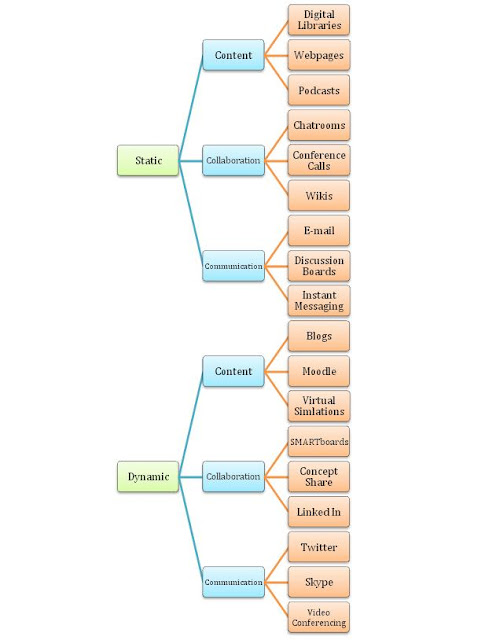Media and Technology in Distance Education
Reflecting on the static-dynamic continuum, I would say that I fall in the middle. As far as static technologies, I still use text, web pages, and podcasts for gathering information. Through my experiences thus far through Walden University, I have learned how to collaborate and build knowledge through communications with individuals and groups using discussion boards, blogs, and wikis. Throughout my current courses and other recent courses, I have learned how I can move towards integrating more dynamic technologies into my instruction, which “includes tools that involve learners on a much deeper cognitive level” (Moller, 2008, p.1). In the future, my goals are to integrate more virtual simulations and multi-user virtual environment experiences to enhance student motivation and support their learning. Using programs such as ConceptShare will encourage collaboration and enhance communications between students. In Fahy’s chapter, he explains that, “any medium that promotes collaboration, group formation, and support could qualify as social software” (Anderson, 2008). I can teach students to use social software tools such as Skype and Twitter for sharing their ideas and communicating with others to gain knowledge. I am also currently in the process of encouraging the adoption of Moodle as a learning management system in my school district, which will enhance access to content, collaboration among students, and communication between instructors and students.
The following blogs also provide examples of media and technology along the static-dynamic continuum:
http://pennyfree.blogspot.com/2010/05/static-dynamic-technologies-concept-map.html
http://belindavannorman.blogspot.com/2011/08/moving-toward-dynamic-technologies.html
References
Anderson, T. (Ed.). (2008). The theory and practice of online learning (2nd ed.). Edmonton, AB: Athabasca University Press.
Moller, L. (2008). Static and dynamic technological tools. [Unpublished Paper].

Tiffany, nice job as you both depict and reflect upon the capabilities of a versatile LMS for students; I find that there are sooooooo many options that it works best for me to build upon what I am comfortable with, then proceed with the technology; my school offers great CEU's towards both learning and applying the multimedia presentation resources; virtual simulations are daily offerings in the aerospace training classroom, flight ops, and aircraft maintenance training mediums.
ReplyDeleteDavid
Hi Tiffany,
ReplyDeleteI like your idea about virtual simulations. You mentioned to me before about Skype. I would love to try and incorporate Skype or some form of virtual simulations with my class. The county I work for does not support Skype for our classes. My hard drive has crashed in my computer so therefore, I am using the schools laptop. Do you know of any other programs that can be used in elementary education?
Brigit
Brigit,
ReplyDeleteWhyville is a virtual world where your students can create profiles and interact online. It does not allow the students' faces to be seen as a security feature for younger ages. I do not have experience with it, but I have researched it. I hope it works for you!
Tiffany